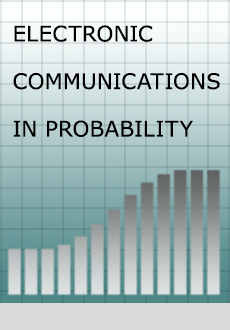Abstract
We study a competitive stochastic growth model called chase-escape in which red particles spread to adjacent uncolored sites and blue particles only to adjacent red sites. Red particles are killed when blue occupies the same site. If blue has rate-1 passage times and red rate-$\lambda $, a phase transition occurs for the probability red escapes to infinity on $\mathbb{Z} ^{d}$, $d$-ary trees, and the ladder graph $\mathbb{Z} \times \{0,1\}$. The result on the tree was known, but we provide a new, simpler calculation of the critical value, and observe that it is a lower bound for a variety of graphs. We conclude by showing that red can be stochastically slower than blue, but still escape with positive probability for large enough $d$ on oriented $\mathbb{Z} ^{d}$ with passage times that resemble Bernoulli bond percolation.
Citation
Rick Durrett. Matthew Junge. Si Tang. "Coexistence in chase-escape." Electron. Commun. Probab. 25 1 - 14, 2020. https://doi.org/10.1214/20-ECP302
Information





